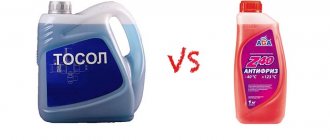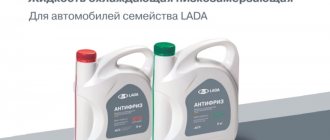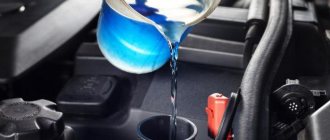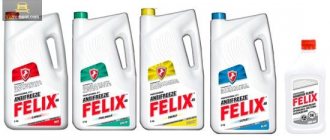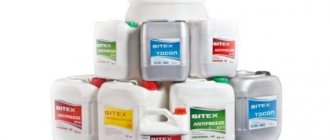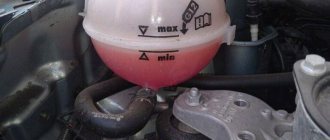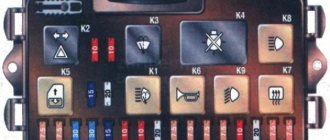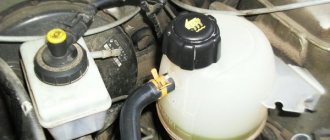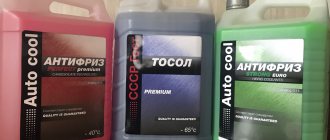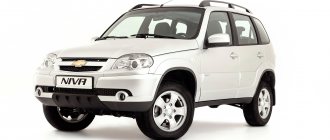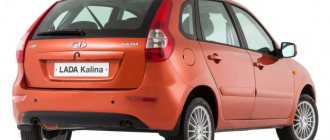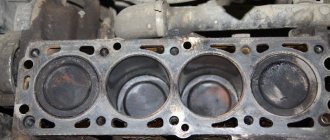01/24/2022 8 006 Coolant
Author: Victor
The purpose of the refrigerant is to provide high-quality cooling of the machine’s power unit and prevent it from overheating. If the system uses fluid that does not meet engine specifications, it will cause serious problems. We will tell you below how to find out whether antifreeze or antifreeze has been filled, and why the driver needs it.
[Hide]
Origins of the problem
As we already said, car owners usually know what they put into the cooling system. But there are times when the driver does not have reliable information. The following typical situations can be distinguished:
- The used car was recently purchased, but the buyer forgot to ask the former owner about what consumables were used.
- The car was received at work for long-term use. The previous employee could simply quit and not talk about how he serviced the vehicle.
- The driver notices that the cooling system is not working correctly. In this case, you can suspect that the wrong coolant was filled in at the car service center, but this needs to be checked somehow.
What else should you pay attention to?
One of the most important characteristics of antifreeze is temperature. The temperature at which antifreeze begins to crystallize is –40 °C. Once it is reached, the first signs of freezing appear. This temperature indicates the lower threshold for antifreeze use. At a temperature of complete freezing (–43 °C), the antifreeze completely turns into a gel.
The boiling point of the liquid at atmospheric pressure should be at least 108 °C, preferably 110 °C (modern engines are becoming increasingly “hot” - temperature-stressed). Most often, in a closed cooling system, the pressure is higher than atmospheric, so there is another reference characteristic: the boiling point at a pressure in the system of 2 atmospheres. There are different values: from 123 to 129 °C.
When purchasing antifreeze from an independent manufacturer, you need to make sure that the liquid will withstand the service life established by the technical regulations. Carboxylate antifreezes have a long service life - 5 years or 250,000 km. It happens that there is no expiration date on the antifreeze package at all. Or on the front label there is the inscription G12+, and on the back label a period of 2 or 3 years is indicated. In this case, there is no need to waste time finding out what the service life of the product is or why Long Life antifreeze only lasts 2 years - it’s easier to choose something else.
Differences in chemical composition
It must be said right away that any antifreeze and antifreeze are special automotive coolants. Only the last option is considered an exclusively domestic development, the roots of mass use of which go back several decades. In the Soviet era, only antifreeze was available to motorists. At this time, the question of how to determine what kind of antifreeze was poured into the car simply did not arise.
Relevance of the issue
Recently, a large number of modern coolant options have begun to appear on the market. Moreover, a clear division into antifreeze and antifreeze appeared. Some people believe that the difference is only in color, but this is not entirely true. In fact, the color of the coolant is not regulated by regulations. Therefore, the choice of colors depends only on the preferences of the manufacturers. For example, original VAG antifreezes are turquoise. And the blue color of antifreeze can be considered a tribute to tradition.
I only need G12!
G11, G12, G12+, G12++, G13 are the specifications of Volkswagen antifreeze, which are applicable only to cars of this concern! If the owner of, for example, a Kia comes to the store and asks for G11 or G12 antifreeze, it’s the same as if he asked for oil with VAG 507.00 approval. Moreover, the G11 specification has not been used by VAG since 2012, G12 - since 2004! Now the concern's cars are equipped with G12+, G12++ and G13.
Therefore, if you do not have an Audi, Skoda, Seat, Volkswagen, Bugatti, Porsche, the G specification has nothing to do with you. You need antifreeze approved specifically for your car.
Real differences between antifreeze and antifreeze
Domestic coolant and its modern “competitors” differ primarily in their chemical composition. It is he who determines their operational characteristics. Antifreeze contains distilled water, ethylene glycol and a special mixture of inorganic acids. Silicates, nitrates, nitrites and phosphates are used as additives.
What does antifreeze consist of?
The base is distilled water, ethylene glycol and additives. It is in the additives that the main difference between the compositions lies. Only organic derivatives are used here. Additives provide anti-foam and anti-corrosion properties of the coolant.
To change or not?
If the antifreeze level has decreased slightly over time and you need to add 200–400 ml, then most likely this is a consequence of the natural evaporation of water from the coolant. In this case, according to Carville Racing engineers, you just need to add distilled water.
If antifreeze has leaked out due to a leak that has been eliminated, but you need to add no more than 1 liter of liquid, it is best to use the same composition that was originally filled. If it was not possible to determine what kind of antifreeze was poured into the car, or more than 1 liter needs to be added, or the deadline has reached in accordance with the maintenance regulations, the antifreeze must be completely replaced.
Important! Under no circumstances should you refill previously used antifreeze that was drained before repairs. In some types of antifreeze, the anti-corrosion compounds are activated once the engine is primed and reaches operating temperature for its entire service life, leaving very little inhibitor in the fluid itself. The additive composition may be depleted, and contaminants may appear in the fluid.
How different coolants work
Features of antifreeze
The formula of the domestic composition works in such a way that a thin protective film is formed on all surfaces of the cooling system. It not only helps fight corrosion processes, but also significantly reduces heat transfer. Due to an increase in engine temperature, fuel consumption increases, and the life of the power unit also suffers. It should also be noted that the silicates and phosphates that make up the refrigerant over time form an insoluble precipitate that settles on the internal walls of the lines and radiator, which reduces the cooling efficiency and leads to the inevitable replacement of parts. And antifreeze loses its properties after 30–40 thousand kilometers.
Features of antifreeze
The composition includes special anti-corrosion additives that form a protective oxide layer only in those places that have already begun to oxidize. Therefore, antifreeze does not reduce the efficiency of the cooling system. Standard trains are designed for 100–150 thousand km. If you buy high-quality antifreeze, then deposits will not accumulate on the inner walls.
How to choose antifreeze by car make?
Operation25 August 2017
The choice of automotive coolants is now quite wide. So much so that it is not surprising for an ignorant driver to get confused - the market offers products of different price categories, differing in colors and characteristics. This raises the question, is it possible to select antifreeze according to the make of the car or do other parameters need to be taken into account? In reality, the factory brand and model of the machine does not play a big role, what is important is the quality and properties of the composition that you buy.
What should you consider when choosing?
Few owners of expensive and luxury cars buy antifreeze personally, since this issue is decided by the staff of the car service center where they are serviced. But owners of cars in the middle and budget price category, who are independently worried about their “iron horses,” need to understand a simple rule: any liquid (except for fakes) is suitable for cooling the engine, regardless of the make of the car. The question is: how long will it last and how much harm or benefit will it bring to the power unit.
Therefore, before choosing antifreeze, it is necessary to formulate the requirements for it:
- The minimum boiling point is not lower than 110 °C.
- The freezing threshold must correspond to the climatic conditions of the region where you live.
- Foaming tendency and viscosity should be kept to a minimum.
- It is imperative to have additives that prevent the formation of deposits on the internal surfaces of engine channels and other system elements.
- Aggression towards metal is close to zero.
- The composition should last as long as possible without loss of properties.
An important factor is the size of the budget allocated for the purchase of liquid. Cheap products will have to be changed much more often - once a year, more expensive analogues can last up to 3 years.
Types of coolants
Non-freezing antifreeze for cars is made on the basis of dihydric alcohols - ethylene glycol and propylene glycol. During the production process, distilled water and various additive packages are added to it, providing anti-corrosion and heat transfer properties of the liquid. The mentioned alcohols in their pure form gradually destroy metals, especially the aluminum alloy from which modern cylinder heads and blocks are made.
Important! Initially, antifreeze is a colorless chemical composition. Manufacturers paint it in various shades at their discretion. But since there is no single classification for this parameter, the color of the liquid does not indicate a specific characteristic of the product and is not taken into account when choosing.
When dividing automobile antifreezes into classes, the system developed by Volkswagen engineers is most often used:
- G11 (English name - Traditional coolants) - “anti-freeze” based on ethylene glycol with a package of silicate additives;
- G12 (Carboxylate coolants) – the same, with carboxylate additives;
- G12+ and G12++ (Lobrid coolants) - the same, but with hybrid additives containing inorganic and organic additives (carboxylic acids, silicates, phosphates, etc.);
- G13 is a liquid based on propylene glycol with the same hybrid additives.
Ethylene glycol differs from propylene glycol in toxicity and lower price, otherwise the properties of alcohols are identical. That is, G13 class products are safe and environmentally friendly compared to G12+ and G12++ antifreezes. Naturally, their price is significantly higher.
Reference. Russian coolant for cars called “Tosol-A” is the same ethylene glycol antifreeze of the G11 class, synthesized in the former USSR and manufactured by private companies to this day.
Now about the properties that various chemical additives impart to the coolant:
- Thanks to silicate additives, all surfaces washed with Antifreeze G11 are covered with an anti-corrosion protective film. It is short-lived: after 1–1.5 years, the coating begins to crumble in the form of small particles traveling through the system and acting on the aluminum walls of the cylinder head as an abrasive. Hence, the maximum service life of class G11 products is 2 years.
- Carboxylate additives do not create films or abrasive particles, and act on corrosion sites after their formation. The G12 connection is more stable and can work for 3 years without problems.
- Hybrid (otherwise known as lobrid) additives create the thinnest protective coating and at the same time eliminate corrosion. They combine the best qualities of carbon and inorganic additives, due to which the service life of G12+ and G13 products without loss of anti-corrosion properties is 5 years.
The chemical composition has a significant impact on the selection of antifreeze for cars. Liquids based on propylene glycol G13 must not be mixed with other types: after the interaction of two different alcohols, a precipitate appears in the form of flakes that can clog any channel or pipe of the system. It is also not recommended to mix products of different classes and manufacturers - among the additives there may be substances that neutralize each other.
Recommendations for selection
It is worth repeating the first rule of choosing the right coolant - you should not focus on the color of the composition. If we consider products from well-known manufacturers, the following pattern is observed when staining antifreeze:
- class G11 has blue and green shades;
- G12 and G12+ are marked in red, yellow and orange;
- propylene glycol liquids G13 are tinted violet or pink.
Since not all companies adhere to this trend, focusing on color is pointless. But the selection of coolant by car make rather consists of dividing cars by year of manufacture. For example, it is acceptable to fill the engines of old cars made before 2000 with Antifreeze or another G11 cooler, because their cylinder blocks were cast from cast iron. Newer cars require modern chemistry - fluid class G12 and higher.
Advice. Cheap antifreezes of the G11 series can also be used, the main thing is to meet the mandatory condition: replacement with a maximum interval of 2 years.
The use of new high-tech fluids is justified in cars of all makes and years of manufacture. Judge for yourself: cooler G11 is replaced once every 2 years, and cooler G13 - every 5 years. If you compare the prices of products plus replacement work, the cost is almost equal.
A few words about which brand of antifreeze is best to buy for your car. There is no doubt about the products of European and American brands Shell, Texaco or Total. Among domestic manufacturers, it is worth highlighting Lukoil; they beat Western ones in price. But in the current realities, a famous brand is not always good, since the market is full of counterfeits. The main thing is to buy high-quality antifreeze and not to pour fake antifreeze into the cooling system of your car.
How to determine what is flooded in practice
When we have already studied the chemical and operational features of antifreeze and modern antifreeze, it’s time to figure out how to distinguish them. Let us remind you right away that you cannot rely on the color of the liquid. While antifreeze is almost always blue in color, antifreeze manufacturers use a variety of dyes, including blue ones. And of course, you cannot use taste buds to determine the type of coolant. Yes, there are rumors that antifreeze is a little sweet, but we strongly do not recommend checking this, because coolants contain toxic substances that, even in small dosages, can seriously harm your health.
I have red antifreeze - do you have red?
Antifreezes, which are used by automakers for filling at the factory, are liquids consisting of 4 components:
- demineralized water
- ethylene glycol (in Volkswagen cars can be replaced by glycerin, but not more than 20%)
- a package of additives that stops severe corrosion of metals and corrosion of polymers of the cooling system from ethylene glycol
- dye
The first 3 components are transparent. The dye is added so that antifreeze from different manufacturers differs in some way in appearance, except for the label and the color of the canister (many brands even use the same canister - for example, Volvo, Land Rover, Motul).
When choosing antifreeze, you cannot focus on color. You only need to look at the tolerance of antifreeze, by analogy with oils. Therefore, either the original or a rebrand of the original.
Methods for determining coolant type
There are safer and more accurate ways to understand what kind of coolant is in your car. Let's look at the most popular methods:
- Smell and tactile sensations . High-quality antifreeze is practically devoid of aroma, and it feels very oily to the touch. Domestic refrigerant has a characteristic chemical odor, and its lubricating qualities are not so obvious.
- Mixing with water . You can try making a solution of water and coolant in a 1:1 ratio. When preparing it, the composition must be thoroughly mixed and left at rest. If after a few hours the contents began to become cloudy or separate into fractions with different densities, then antifreeze was poured into the car. High-quality antifreeze mixes well with water in any proportion.
- Density measurement . This is perhaps the most accurate method for determining the type of coolant. But for its practical use you will need an aerometer - an inexpensive device for measuring the density of a liquid. Measurements must be taken at room temperature. If the readings range from 1.073 to 1.079 g/cm³, then this is a good antifreeze. High-quality antifreeze always has a lower density, since its standard value is 1.065 g/cm³.
Folk way to determine coolant
Experienced craftsmen often use the following technique to distinguish antifreeze from antifreeze. To check, you will need any steel part with pockets of corrosion and some rubber (for example, you can use a section of a cooling system pipe). These products should be placed in a container with coolant for a short time. Domestic antifreeze will form a protective film on all surfaces. Modern antifreeze has a more “smart” formula, since the composition leaves an oxide film only on metal that has been subjected to corrosion processes. Therefore, if after removal the rubber has a slippery coating and the steel part is completely covered with a film, antifreeze was used in the experiment. If only the spots of rust on the metal changed color, and the surface of the rubber did not change its qualities, then there was high-quality antifreeze in the container.
How to be 100% sure
All the described methods for distinguishing antifreeze from antifreeze are quite accurate, but they still do not provide a complete guarantee. For example, you can never exclude the risk of purchasing a low-quality composition that simply does not exhibit characteristic qualities. In order not to risk the health of the engine, experienced drivers recommend playing it safe. If you start using your car, but do not know what kind of refrigerant circulates through the cooling system, then it is better to replace it with a composition that is known to be of high quality. You should first flush the lines and radiator using special compounds or distilled water. You will spend a small amount of money on this, but you will get 100% confidence that the car is being used correctly.
Let's sum it up
Now you know how to understand what kind of coolant is in your car and why it is important. Remember that 100% conclusions can only be drawn after a laboratory examination. But in practice, it is easier to replace an unknown coolant with a new composition purchased in a reliable place.
#Advice from experts
You may also be interested
How do antifreeze differ in color? What is the difference between coolants?
Not many people realize, but the color of the coolant is completely unrelated to its chemical composition and performance properties. Moreover, international standards do not contain strict regulations regarding the color of technical fluids. Then why is antifreeze painted in different colors? Our experts gave a detailed answer in the article.
How to determine what is filled: antifreeze or antifreeze
It is possible to accurately determine the type of refrigerant in the radiator of your car only in laboratory conditions, but this is not always possible. Therefore, car owners often use more affordable methods. Let's talk to experts about which ones really work.
